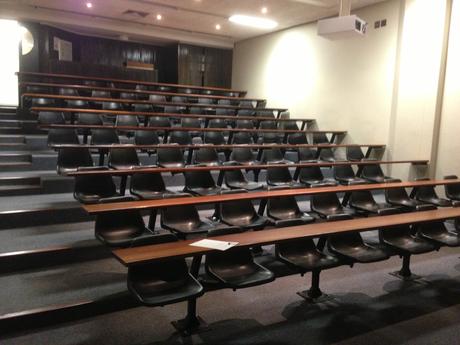
The subtle sexism of being a woman in male-dominated college classes.
The spring semester of my freshmen year of college, I took a class called “Intro to Political Theory.” I was obsessed with the syllabus (Kant and Marx make my head hurt in all the right ways) and more than ready to start studying the topics I was most passionate about after a painful semester of Bio 101 (I will never touch another microscope as long as I live). But on the first day, as I walked in bright-eyed, bushy-tailed and equipped with a fresh notebook, I noticed something: the majority of the class, including the professor, was male.
I thought I was prepared for this; it’s no secret that politics is an incredibly male-dominated field. But as a student at a liberal arts school, I had certain expectations for my experience. “It’s different here,” I told myself. But listening to my professor dissect Aristotle, I realized that I had taken for granted the blanket of comfort that female-identified majority classes with female professors had swaddled me in my previous semester. For the first time that year, I felt small and realized that the power structure women exist in is not transcended even by the “progressive” bubble of a liberal arts college.
Day after day, I would sit in the same seat as far away from my professor as possible, while he conversed with students about the reading. I always spent hours on these assignments, but felt as if I had nothing to say about them in this environment. Even when I did have a comment, I would wait around for some guy to say the exact same thing, suddenly losing all confidence in my idea, subconsciously waiting to be validated by a male voice. I was paranoid that my intelligence would be questioned, and accepted silence in lieu of the possibility of being called out for being wrong — for being a woman in a space traditionally unwelcome to my gender.
When finals rolled around, I reflected upon the toll that this deep-rooted sense of fear had taken on my success in the class. I never went to my professor’s office hours out of sheer insecurity, and so all of my questions went unanswered. I flunked a lot of quizzes despite countless hours of studying.
But the more I mulled over my situation, I came to realize that in actuality I probably knew just as much, if not a lot more, than many of the guys in that room. Despite the confidence they exuded, my male peers were probably also mentally decimated after hours of meticulous, yet seemingly unsuccessful, reading. But as a woman, I felt forced to prove — and in this case, incapable of proving — myself in ways that my male peers likely didn’t.
This feeling of never measuring up, of never experiencing the privilege of self-assurance, made being a student absolutely nerve-wracking, but is also part of a much larger gender-based double standard. For centuries, we’ve all been taught that there’s some nebulous gap of ability between genders. This fabled, internal obstacle — as well as clear external obstacles, like workplace harassment and the wage gap — encourages women to overcompensate and leads to the genuine belief that we are somehow inherently less worthy. Gender always seems to take center stage for women, even when we’re in prestigious places. The praise women receive for their accomplishments is silently accompanied by the knowledge that they overcame something men don’t have to. And because of that, we have come to simply expect everything to be a little more challenging.
Supporting other girls and their achievements, especially in male-dominated fields and spaces, is so important. But ultimately, I want what I do in this world to be impressive based on its own merit — not just because it’s the result of a woman overcoming a patriarchal power dynamic. I want this internalized feeling of being something less to disappear. And I don’t want any girl in academia, and beyond, to feel the way that I felt in that classroom.

